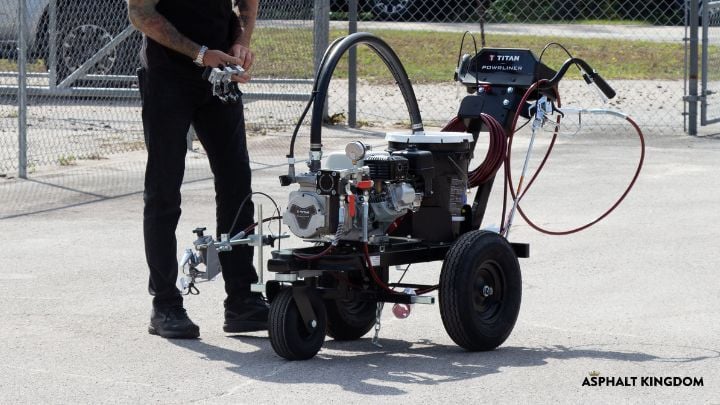How can you ensure asphalt projects meet client expectations and comply with evolving safety regulations? Adhering to fire lane requirements is one critical aspect. These regulations are pivotal in ensuring emergency vehicles have unobstructed access when every second counts.
However, each state has its rules, and updates are rolling out for 2025. Keeping track of fire lane requirements can feel like chasing a moving target, but this comprehensive guide will help you navigate the maze of fire lane regulations across the United States.
Why Fire Lane Requirements Matter
Delays in emergencies are not just inconvenient, they can also be deadly. A National Fire Protective Association (NFPA) report found that response times exceeding five minutes significantly increase damage and the risk of fatalities. Fire lane requirements are carefully crafted rules to clear emergency access when seconds could mean life or death. Think of fire lanes as lifelines painted on the pavement to ensure fire trucks, ambulances, and first responders can do their jobs without roadblocks.
Updated Fire Lane Requirements By State as of 2025
Staying up-to-date with specific fire lane requirements is crucial. Here’s a snapshot of the latest regulations by state in 2025:
Alabama: Fire lanes must be marked with red curbs labeled “No Parking—Fire Lane.”
Alaska: Fire lanes must be a minimum width of 20 feet and within 150 feet of building entrances.
Arizona: New regulations mandate fire lanes to have a vertical clearance of 14 feet.
Arkansas: Fire lanes must be marked with signage every 50 feet.
California: Fire lanes must be 26 feet wide in areas with buildings exceeding three stories.
Colorado: Fire lanes must be within 50 feet of building entrances and marked with red striping.
Connecticut: New fire lane requirements mandate a minimum width of 24 feet.
Delaware: Fire lanes must be marked with signage and painted curbs.
Florida: Fire lanes must be 20 feet wide with a vertical clearance of 13.5 feet.
Georgia: Fire lanes must be marked within 50 feet of building entrances.
Hawaii: New regulations mandate that fire lanes be at least 20 feet wide and marked with red paint.
Idaho: Fire lanes must be marked with signage and maintained free of obstructions.
Illinois: Fire lanes must be 20 feet wide and marked with “No Parking—Fire Lane” signs.
Indiana: New fire lane requirements must have a vertical clearance of 14 feet.
Iowa: Fire lanes must be marked within 150 feet of building entrances.
Kansas: Fire lanes must be 20 feet wide and marked with red striping.
Kentucky: New fire lane requirements must have a minimum width of 24 feet.
Louisiana: Fire lanes must be marked with signage every 50 feet.
Maine: Fire lanes must be at least 20 feet wide with a vertical clearance of 13.5 feet.
Maryland: Fire lanes must be marked within 50 feet of building entrances.
Massachusetts: Fire lane requirements mandate a minimum width of 20 feet and be marked with red paint.
Michigan: Fire lanes must be marked with signage and free of obstruction.
Minnesota: Fire lanes must be 20 feet wide and marked with “No Parking—Fire Lane” signs.
Mississippi: New regulations require fire lanes to have a vertical clearance of 14 feet.
Missouri: Fire lanes must be marked within 150 feet of building entrances.
Montana: Fire lanes must be at least 20 feet wide and marked with red striping.
Nebraska: New regulations mandate fire lanes to have a minimum width of 24 feet.
Nevada: Fire lanes must be marked with signage every 50 feet.
New Hampshire: Fire lanes must be at least 20 feet wide with a vertical clearance of 13.5 feet.
New Jersey: Fire lanes must be marked within 50 feet of building entrances.
New Mexico: New regulations require fire lanes to be at least 20 feet wide and marked with red paint.
New York: Fire lanes must be marked with signage and maintained free of obstruction.
North Carolina: Fire lanes must be at least 20 feet wide and marked with "No Parking—Fire Lane" signage.
North Dakota: New regulations mandate fire lanes to have a vertical clearance of 14 feet.
Ohio: Fire lanes must be within 50 feet of building entrances and marked with red curbs.
Oklahoma: Fire lanes must always be at least 20 feet wide and free of obstructions.
Oregon: Fire lanes must be marked with signage every 50 feet.
Pennsylvania: Fire lanes must be at least 24 feet wide and clearly designated with pavement markings.
Rhode Island: New regulations require fire lanes to be at least 20 feet wide and include reflective striping.
South Carolina: Fire lanes must be located within 150 feet of the building entrances and adequately marked.
South Dakota: Fire lanes must be debris-free and designated with red-painted curbs.
Tennessee: Fire lanes require a vertical clearance of at least 13.5 feet.
Texas: Fire lanes must be within 50 feet of building access points and designated with "No Parking—Fire Lane" signs.
Utah: Fire lanes must be 20 feet wide, marked with red curbs, and always kept clear.
Vermont: Fire lanes must be adequately striped and include clear signage to indicate emergency vehicle access.
Virginia: Fire lanes must allow emergency vehicle access within 50 feet of a building entrance.
Washington: Fire lanes require a vertical clearance of 14 feet and must be marked with reflective paint.
West Virginia: Fire lanes must be marked with signs and always free of parked vehicles.
Wisconsin: Fire lanes must be designated with pavement markings and curb signage.
Wyoming: New regulations require fire lanes to be at least 20 feet wide with posted enforcement signage.
Remember—some states have yet to revise their fire lane requirements for 2025, so the state requirements are the most current. Contact Asphalt Kingdom for more information about 2025 fire lane requirements.
.jpg?width=720&height=405&name=Blog%20Images%20(26).jpg)





-2.jpg)